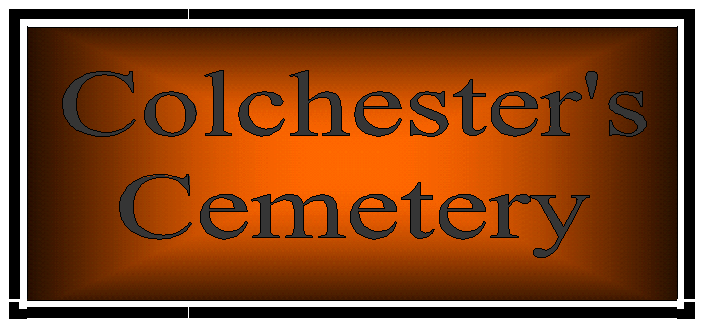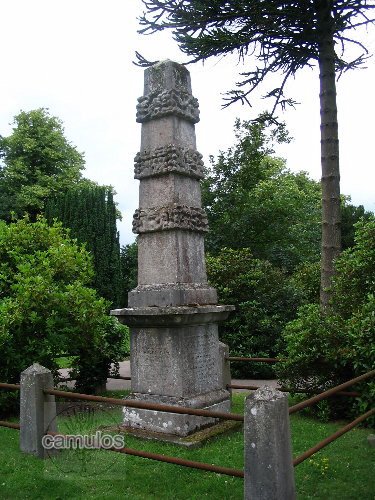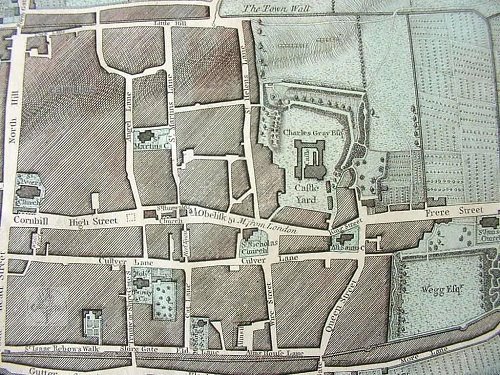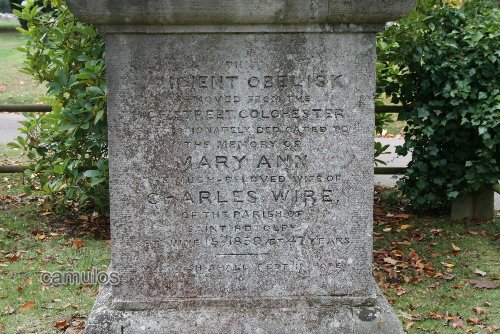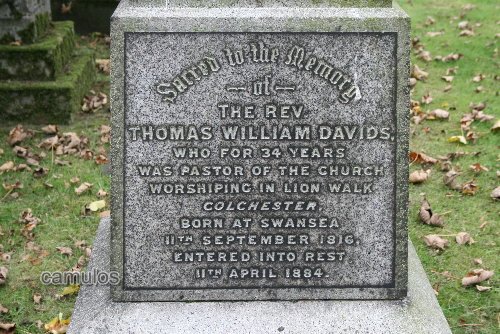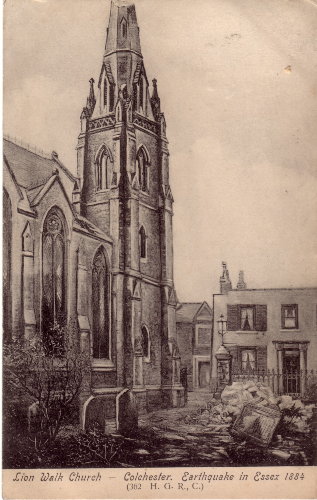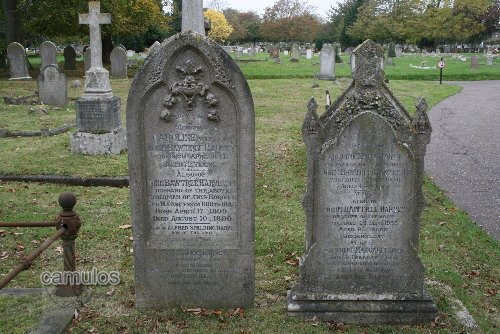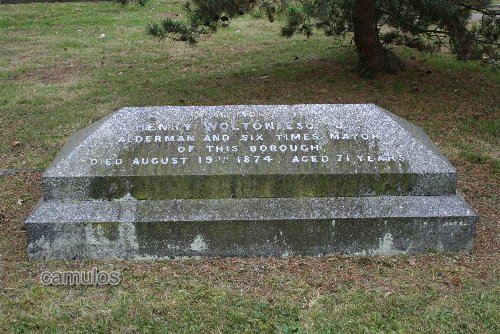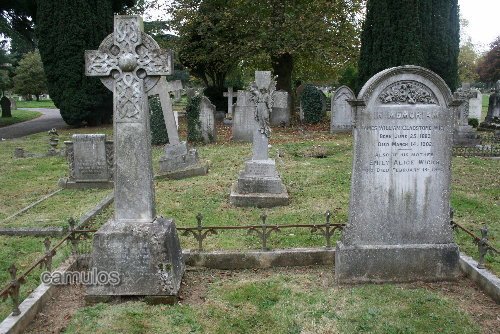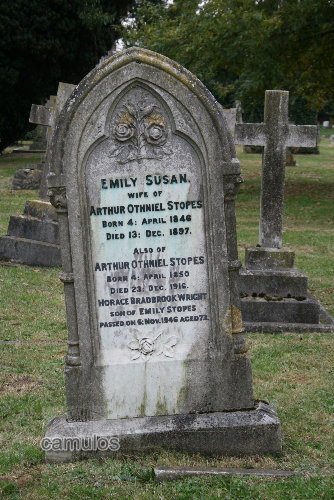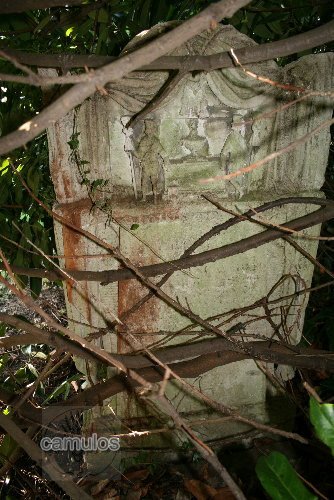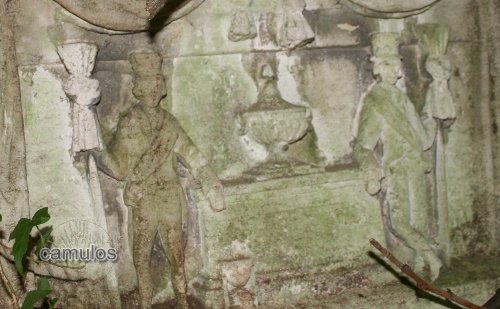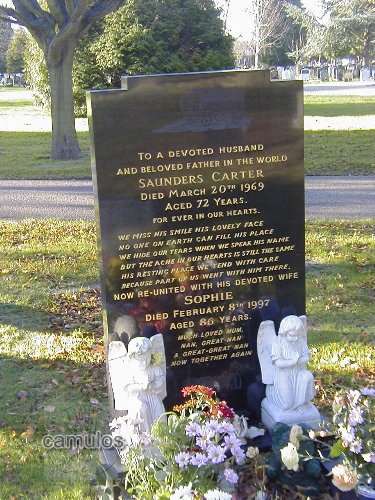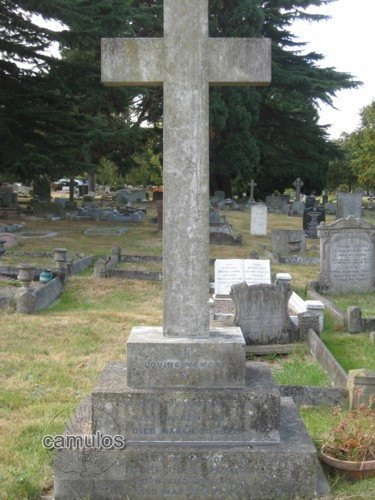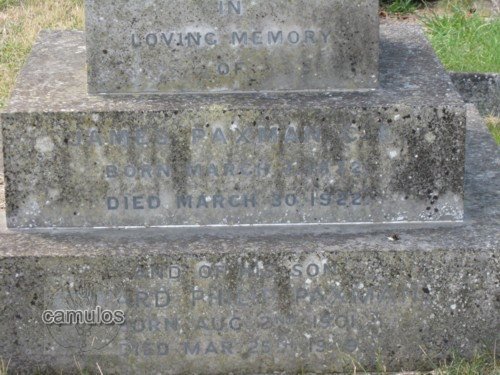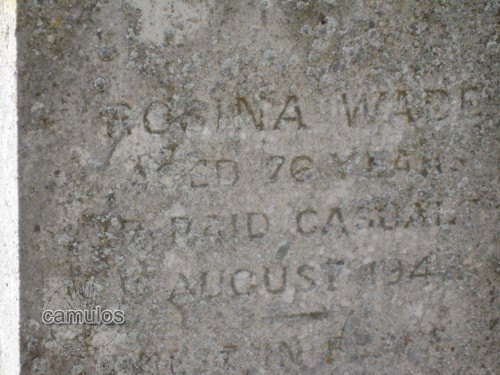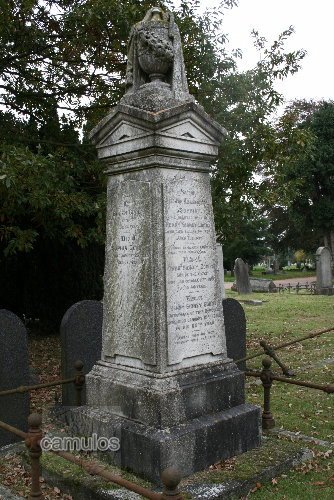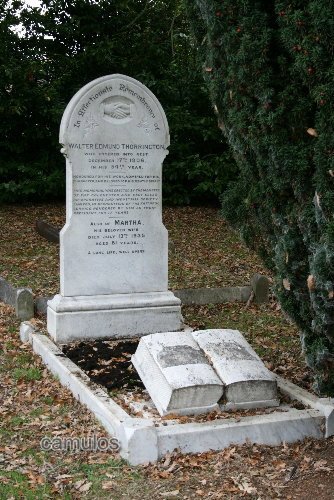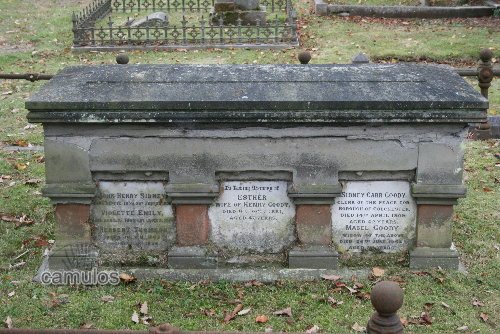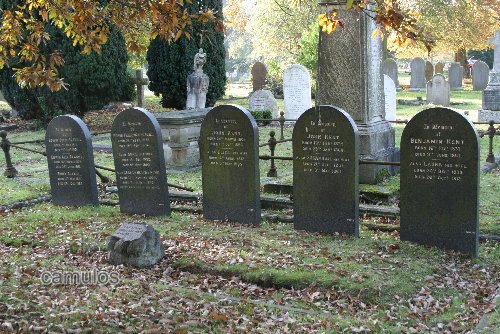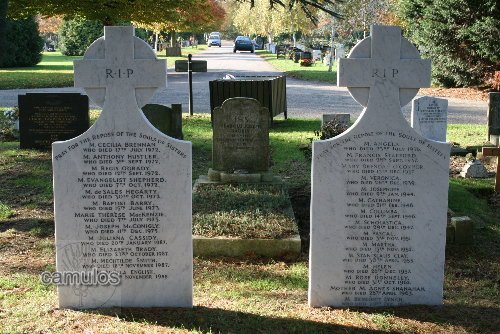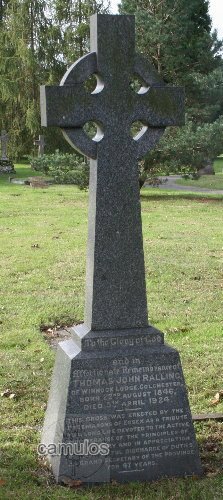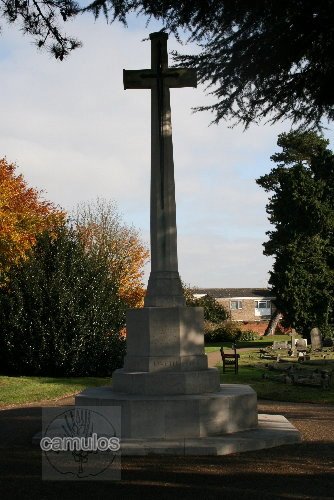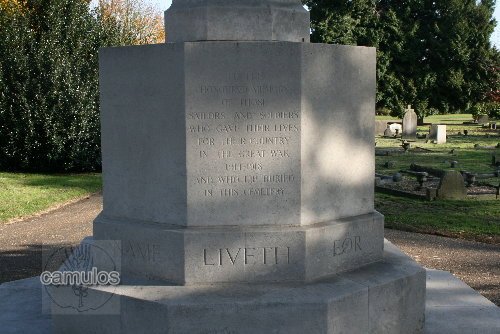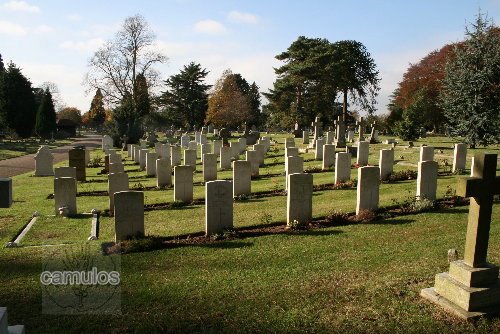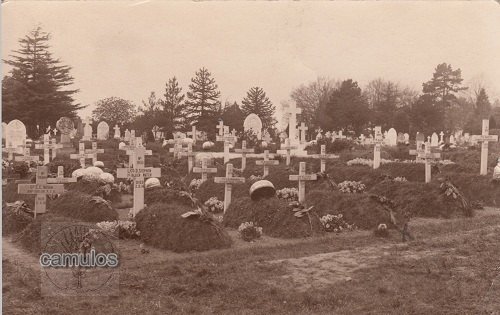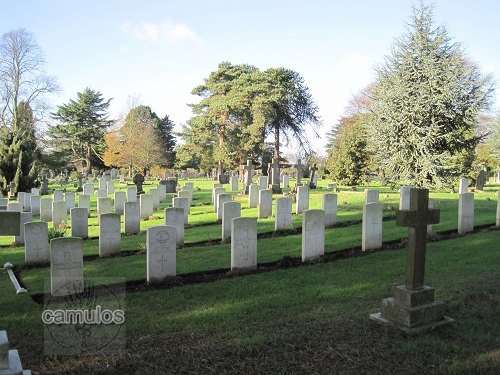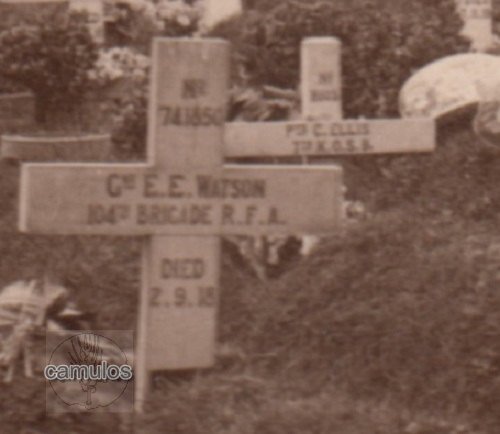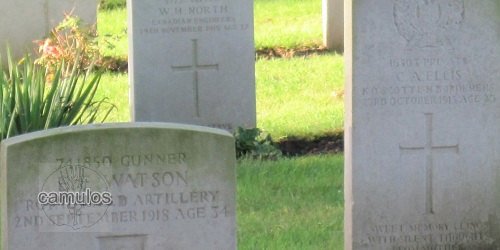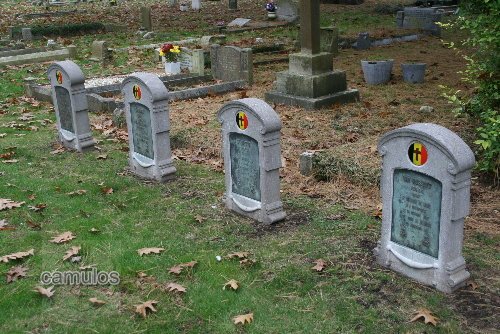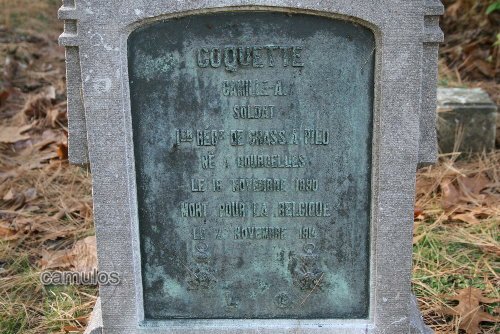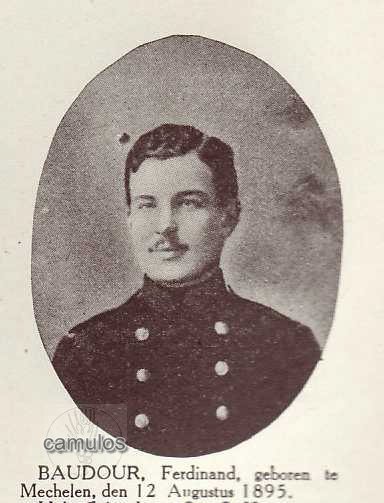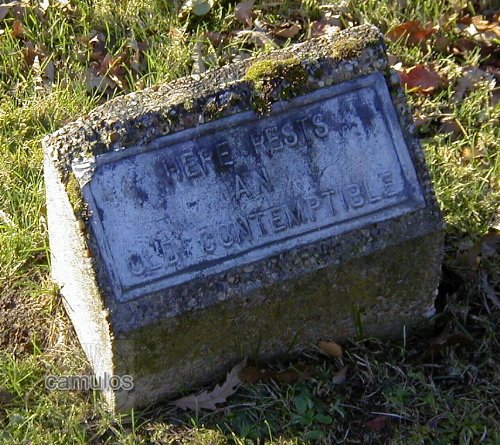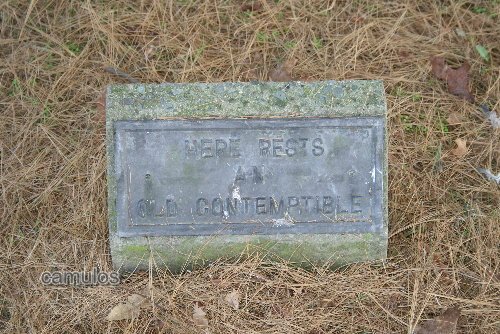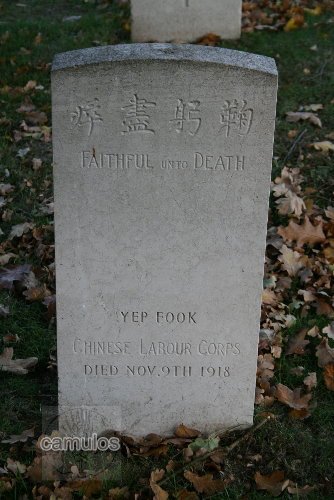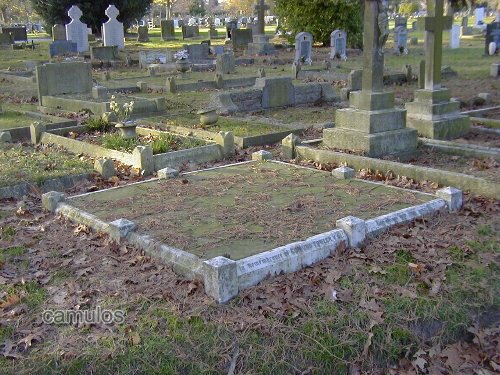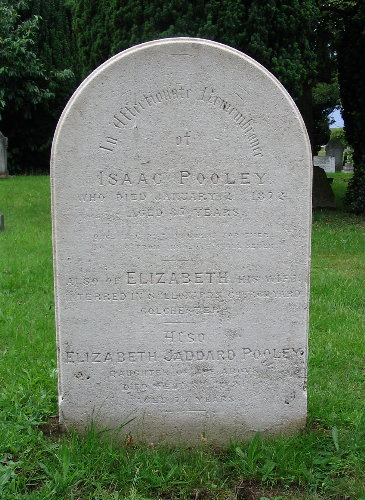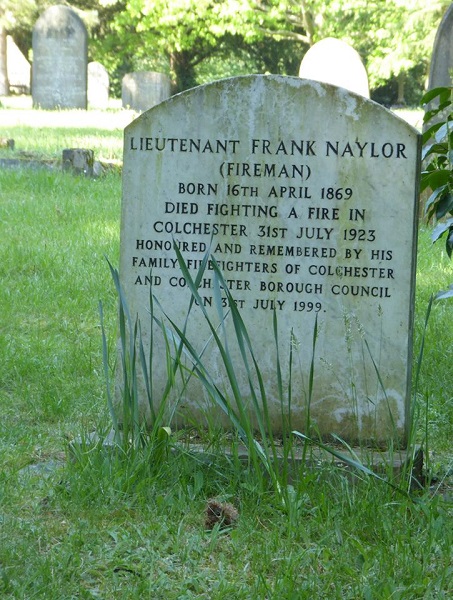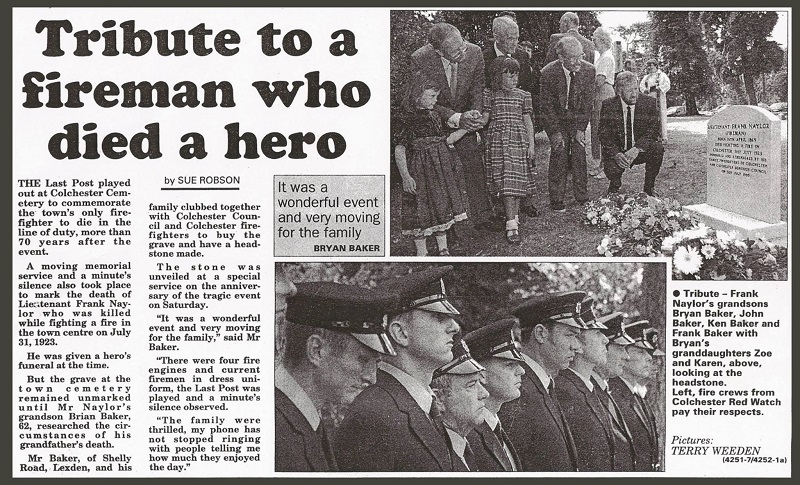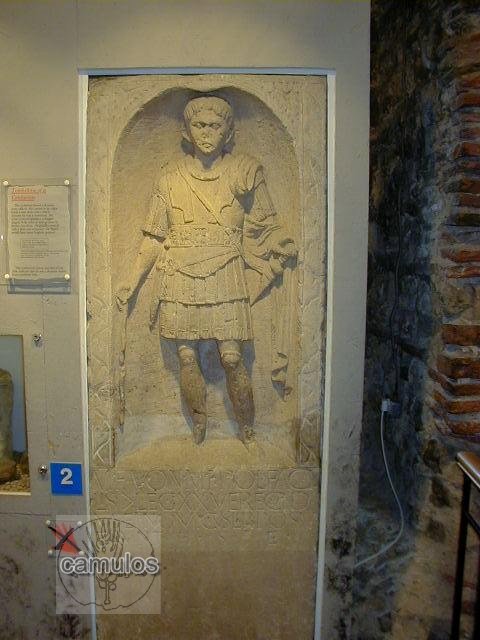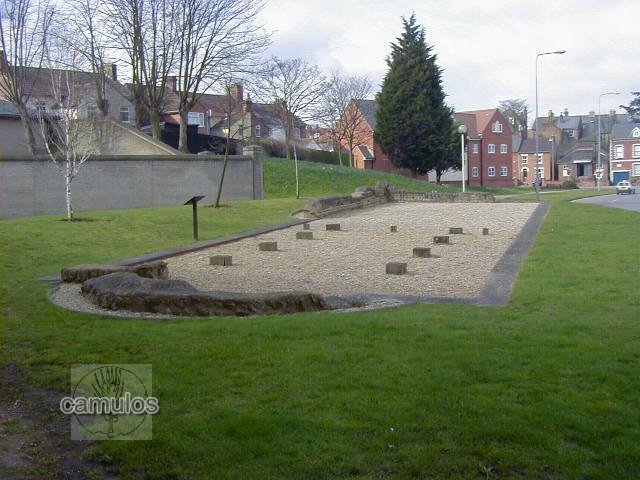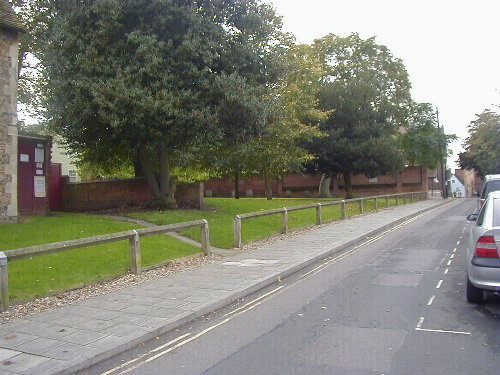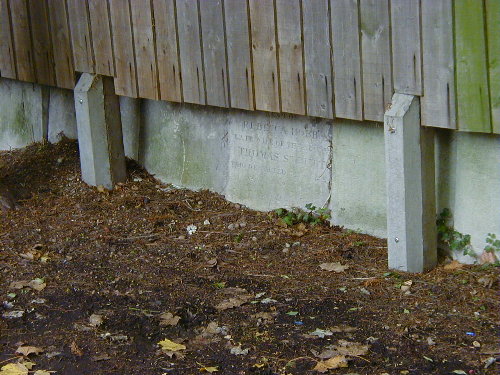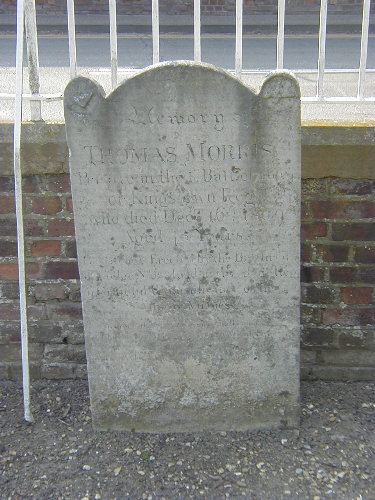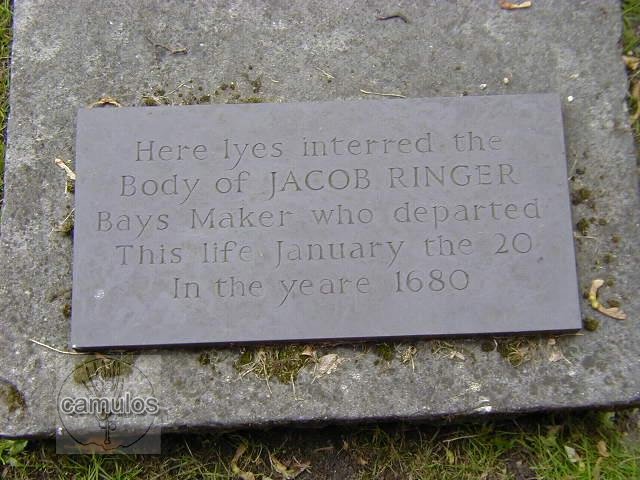An unofficial guide to
Colchester Cemetery and Crematorium
Mersea Road, Colchester, Essex CO2 8RU
Telephone: 01206 282950
E-mail: cemetery@colchester.gov.uk
In 1854 the closure of all the town's churchyards was ordered, except for St. Mary Magdalen's, where burials continued until 1892. Representatives of all eleven parishes formed a single burial board and bought from G. Tettrell 18 acres of land on the west side of Mersea Road which, in 1856, was consecrated as a burial ground and became known as Colchester Cemetery. Two chapels, and a house for the superintendant were built. In 1896 Colchester corporation assumed the duties of the burial board. The cemetery, extended in 1895 by approximately 12 acres, had been enlarged to more than 57 acres by 1937. The borough crematorium, south of the cemetery, was opened in 1957.
The cemetery was enlarged in 1940 to 67 acres. The newer part is on the western side of the original burial ground, and behind it is the site of a Roman Way.
AWARD
Judges praised Colchester Crematorium and Cemetery in the 2007 Cemetery of the Year awards. It won the National Association of Memorial Mason's freedom of choice award which recognised the variety of headstones and memorials that the cemetery offered. Special recognition was given to the provision of a baby memorial garden.
We present this web page to you as a work in progress. There are thousands of burials on this site and hundreds of gravestones. Records of all those buried here can be viewed by appointment at the cemetery and on microfilm at Colchester Library. We have shown a selection of gravestones that caught our eye whilst wandering around the site, many of these being in memory of our Victorian forefathers, so instrumental in shaping the Colchester that we see today. Here is a selection of them.
This web page is for us all. Can you tell us about the life of a person who is remembered on one of our headstones? What was their name, what did they do in life, where is their memorial to be found in the cemetery, etc? Help us to make the memory of the deceased person something that can be shared. Don't let their memorial be something to simply view and pass by. Please contact us here.

1 - We start with an old engraving of the part of High Street where once stood an obelisk. This obelisk was purchased by the Wire family and re-sited at the cemetery.
This obelisk was located in the High Street to the east of St Runwalds Church.
The Essex County Standard of 8th Januray 1858 mentions the removal and sale of the obelisk. A further report is given on 29th January 1858. It was sold for £3 5s 0d to Mr Charles Wire of Magdalen Street. A further report in February stated that the obelisk had been removed and that no coins or memo or record as to the time of its erection were found.
2 - Next we have an inscription from a stone to the Rev Thomas Davids who was pastor of Lion Walk Church for 34 years and who died in 1884. There was (and still is) a strong non-conformist tradition in Colchester. Note the spelling error on the inscription.
A simple record of a dead person? Surely there is more to tell? Drawing heavily on an article by Andrew Phillips published in 1992 on the occasion of Lion Walk Church's 350th anniversary, Andrew tells us that......
'Ministers were usually outsiders, recruited from Homerton College. This sometimes caused friction - never more so than in 1841. In that year, the youthful Thomas Davids became Lion Walk's new minister. He was youthful, evangelical and Welsh. He also had a knack of upsetting others, at a time when Colchester's nonconformists were in turmoil. Next door the Eld Lane Baptists had virtually driven their pastor away, despite his building a handsome new meeting house - which still stands today. Over at Stockwell Chapel, opponents of the Reverend Herrick had removed the chapel roof and had Herrick and his hymn books thrown into the street. Into this emotional minefield, Thomas Davids had stumbled. Before long, a group of Lion Walk dissidents walked out and built themselves a new meeting house. It is still there in Chapel Street, although no longer a chapel. Lion Walk meanwhile, flourished. Branch missions were started and the Sunday School boasted more than 1000 pupils. Thomas Davids became a respected local figure. Like other non-conformists he celebrated the part Independents had played in securing England's political freedom. He unashamedly encouraged close links with the Colchester Liberal Party, campaigned for votes for working men and equal status for non-conformists with the Church of England. Thus, when a third Lion Walk was planned, Davids sought to make his point: A new church, grand and Gothic, with a spire reaching to heaven, soon dominated the Colchester skyline. Waggish Anglicans called the new building, 'St Davids Cathedral'. '
Thomas Davids was buried on 11th April 1884. On 22nd April 1884, came the Colchester earthquake, 'when Lion Walk experienced its most famous moment - the top of the spire crashing down in an earthquake. Was this not proof, whispered some, that the Almighty was an Anglican? Happily, the old spire of St Davids Cathedral still stands as a monument to a distinguished history.'
So, there is more to our cemetery memorials than one might think. Don't just pass them by without a thought. Consider what story might lie behind them.
3 - This impressive obelisk shaped memorial belongs to the Herrick family.
The Reverend Joseph Herrick was interred in Colchester Cemetery by the side of the graves of his wife and mother. A large number of the congregation attended to pay a last tribute of respect to the memory of their late minister. Many of the shops in the streets, through which the mournful cortege passed, were closed. The procession, which consisted of hearse, four mourning coaches (containing his son and son-in-law, the dissenting ministers of the town and principle members of the congregation) and several other vehicles, left the residence of the deceased, 12 North Hill, at half past one o'clock, and proceeded through the High Street to the Chapel, where a numerous and sorrowing congregation, most of whom where attired in mourning, had assembled. The Rev Dr Seaman, rector of St Andrews Greenstead, and several lay members of the Church of England, were among those present in the chapel. The coffin was placed on trestles in the table-pew in front of the pulpit, which was draped with black cloth.
Among the prayers given, the Rev'd T. W. Davids (see his memorial above on this page) read the 90th Psalm, and part of the 4th chapter of the 1st Thessalonians. Another hymn was sung, then the Rev John Raven (of Ipswich ) delivered an impressive address. He included in his speech that, "the coffin below me contains the mortal remains of one who but 12 days ago stood in that pulpit directing our attention to the departing of a fellow member. There are many who leave this world in obscurity, unnoticed in their life and their death, but this is not the case for our departed friend".
On leaving the chapel the procession re-formed, and proceeded through High Street, Queen Street and St Boltoph's Street to the cemetery, headed by 40 members of the congregation, two abreast, wearing silk hat bands. After the coffin was lowered into the grave, a portion of scripture was read by Mr Raven, who also offered a brief concluding prayer. After taking a parting look at the long last home of their beloved pastor, the mourners departed.
++++++++
The principal inscription on the monument reads:
Beneath this stone, waiting for the coming, rests the mortal remains of the Rev. Joseph Herrick who, for more than half a century, was the active and devout minister of the congregational church Stockwell Street in this town endowed with superior talents his highest aim was to concentrate them to the service of God he was a man of sterling integrity who on no consideration would deviate from the path of uprightness.
Born March 28th 1794 - Died January 28th 1865
++++++++
Joseph was born in Wolverhampton 1793/4 to Joseph and Ann Herrick. They moved to London to become jewellers, where Joseph was intended for the same business but, instead, he had decided to become an actor. There is no evidence that he ever trod the boards but we do know that he became involved with the gospel. At the age of 19 he was a Sunday school teacher.
In the early part of 1814 Joseph went to Colchester on probation, in order to undertake the pastorate of the Independent Church, St Helen's Lane, a congregation that originally met in Colchester Castle in the 1600's. In due course, the Rev'd Stockton became minister of what is now Lion Walk, while the Rev'd Warren founded, what is now, Stockwell Street Chapel. On 27th April 1814 Joseph Herrick was ordained to the pastoral charge of the assembly of protestant dissenters in St Helen's Lane. He married Ann Douglass of Clerkenwell, London on the 1st June1814 in Clerkenwell.
Joseph had officiated at St Helen's Colchester, slowly building up a loyal congregation, over two and a half years. It was said that Joseph had almost a mesmeric hold over his female members; so much so that it led to their exclusion from church meetings, while the male membership sought to control him. Joseph's theological beliefs were not popular with all of his flock and, at one time, the trustees of the church launched a pamphlet war against him. When this failed to stop Joseph they sought to silence him. So in 1816 an "unpleasantness" happened, the roof was taken off the chapel, so making the place unfit for use. Undaunted by this, Joseph held services in his back garden and home while his numerous friends quickly erected another place, now known as Stockwell Chapel. Services took place even before it had a roof. When it rained the congregation simply put up their umbrellas.
The new chapel was opened in 1817. Joseph drew very large congregations and soon the building had to be enlarged to seat 1000. The work included the building of a new front on Stockwell Street, and the chapel thereafter was known as Stockwell Street Chapel. He preached three times on Sundays and up to 1500 people attended. Joseph had won his battle and he went on to stay in Colchester for nearly 50 years until his death in 1865.
It seems that Joseph was an affable man as various written records tell of him being often seen spending time over the pig hurdles, asking about or discussing ploughing matters or perhaps talking over the finer points of a Shakespeare.
The inset picture is an engraving of the Reverend Joseph Herrick by R Woodman, being published for the Home Missionary Society in 1826.
This information was kindly supplied by Julie Herrick of Grimsby and a lady named Christine, both of whom contacted us by email. 
4 - Next we have a pair of headstones in memory of the Bawtree Harvey family. In particular, the left hand stone records John Bawtree Harvey, JP, a Liberal, an Alderman and Mayor of Colchester from 1881 to 1883. His successor, Alfred Francis, died in office, leaving Harvey to take a third term as mayor.
5 - Staying with the mayoral theme, the following picture is of the gravestone to Henry Wolton Esq, JP, a Conservative, an Alderman and six times Mayor of Colchester, who died in 1874. He was mayor in 1844, 1845, 1847, 1853, 1856 and 1861.
Borrowing a little from an article written by Colchester historian, Mr Andrew Phillips and which was published in the Essex County Standard of 7th October 2005, concerning Colchester's famous Oyster Feast,
'a major reform of local government forbad all forms of civic feasting. Time to end corruption… that sort of thing. No more Election Dinner, no more Mayor's Dinner. But the little Corporation Lunch (sometimes supper) survived, since they paid for it themselves, except for the oysters which came from the grateful dredgermen. In 1845 the new mayor was Henry Wolton, a great traditionalist. For example, he reintroduced the punishment of the stocks for persistent drunkards - a practice by then unknown elsewhere. He also dramatically renamed the Corporation Lunch, inviting 200 guests to dine at his expense in the newly-built town hall (the one before the present one). Wolton had invented the modern Oyster Feast, by cleverly re-inventing the banned Mayor's Dinner. For this he was re-elected mayor FIVE TIMES.'
So, don't just pass Henry's tomb by. Here lies a good and generous man.

6 - Next, we have a pair of headstones in remembrance of members of the Wicks family. In particular, the stone on the left is to James Wicks, a wine and spirit dealer. A local historian, Mr Gerald Rickword, wrote that, 'the founder of the firm, Mr James Wicks, a freeman of Ipswich, born in 1800, came to Colchester in 1819 with Robert Skitter of the Golden Lion of Cornhill, on his removal to the Three Cups in Colchester, as his clerk. After ten years service, Wicks took over the Bear. In 1841 he opened business at 117 High Street. He died in 1885 and was succeeded in the business by his son James.' The stone on the left appears to commemorate the son James, who died in 1905.
This prompted a response from 87 year old Mr Stanley Wicks, whose grandfather took over the premises in 1841 and of whom he said, 'he was of a philanthropic disposition and his intention in applying for the full off-licence was to give members of the poorer classes an opportunity to buy small quantities of wine or spirits without having to go into ordinary public houses, which could be rather rowdy in those days.'
7 - Next we have a gravestone in remembrance of a man who was very dear to the hearts of the men of Colchester. Arthur Othniel Stopes was managing director of the Colchester Brewing Company whose brewery premises stood on East Hill, with his name inscribed on the foundation stone to mark the occasion. In 1894 the company owned 319 public houses, 58 of them being in Colchester. You can read more of this in, 'The Inns, Taverns and Pubs of Colchester' which is to be found here. There is also believed to be a family connection with Marie Stopes, the groundbreaking (for her time) family planning campaigner.
8 - Next we have a gravestone that proved hard to find. We knew of its existence from a newspaper article (ECS 071094) that featured it in connection with a piece about the cemetery. When asked in 2007, the cemetery staff didn't know where it was, other than that they thought it was completely enveloped by a bush. With that in mind we did indeed discover it as described, around L7, within a very vigorous laurel tree - and in poor shape as a result.
This gravestone is very intricately carved and records the death in 1867 (we are told) of one Isaac Lingwood, aged 85, an undertaker from Melton near Woodbridge in Suffolk. To quote Mr Christopher Ryland, cemetery manager in 1994, 'His headstone has some beautifully carved underrtakers on it, dressed exactly like Charles Dickens described undertakers of the day'. Sadly the tree is damaging the stonework through branches rubbing against the stone. Can nothing be done to preserve it?
The 1851 census shows Isaac Lingwood, aged 63, a widower, living in St Botolph Street, Colchester with his son and daughter, both born in Colchester. Isaac's profession was given as a carpenter, employing one man and his place of birth as Milton in Suffolk. On checking the 1861 census, he is married, aged 78, a stationer, born in Melton, Suffolk. His wife's name was Belisia? aged 48 years. His next door neighbour was his son Edgar and his family. He was married in the first quarter of 1857 at Colchester to, we think, Beatrice Avey.
So, Isaac's gravestone stated that he was an undertaker, which is consistent with his profession of carpenter in the 1851 census. At the age of 74 he married a woman, some 30 years younger than he.
9 - Next we have a gravestone that remembers a Romany family. The top of the stone shows a traditional Romany wagon. An obituary to Sophie Carter, widow of Saunders Carter of Colchester, is shown below.
IMPRESSIVE SEND-OFF FOR ROMANY SOPHIE
A woman who spent her younger days as a true Romany, travelling the countryside with her parents in a vado - a barrel top wagon - before settling in Colchester, has died. Mrs Sophie Carter was 86.
For more than 54 years she had lived in Magdalen Street, where her late husband Saunders Carter ran his business as a scrap metal merchant and marine dealer. For the past two and a half years she lived at the Cheviots in Lexden.
Mrs Carter was born in Brighton and educated there before her parents moved to the Ipswich area. She remembered vividly the first time she saw Saunders Carter, who was wearing a trilby hat and a silk paisley scarf. She was aged 20, but within two weeks they had married.
Their first child, also called Sophie, was born in a manger. The couple had 13 children, 11 surviving, 31 grandchildren, 32 great-grandchildren and one great great-grandchild.
Her family meant, everything to her, and she would recall the old days when her husband used to take part in bare knuckle fights at the fairgrounds, never losing a fight.
The funeral was held at St James the Less Roman Catholic Church. In Romany style, Mrs Carter was taken on her last journey from her youngest in High Dickson Road, with the procession being led by a lorry from the family business S Carter & Sons.
Her coffin was carried into church by two of her sons, Alfie and Reggie, her grandson Saunders, and son in law Tom Rothery. The service was conducted by Father Jean Lauren Marie.
Afterwards, the cortege left the church and travelled down East Hill and up Brook Street, then mourners paid their final tribute by walking the length of Magdalen Street, home of Mrs Carter for so many years.
Following burial at Colchester Cemetery, Mrs Carter's eldest son Jimmy, put his trilby hat in the grave. It had been his father's and was the hat he was wearing when the couple had first met.
(with thanks to Reg Carter for allowing us to mention his mum here in this way)
10 - Next we have the gravestone of James Paxman, probably the most important industrialist the Colchester has ever had. He founded what became one of Colchester's biggest engineering firms, Paxmans, manufacturers of boilers initially and then diesel engines. He died in 1922, having fallen off a roof.
11 - Next we have a row of gravestones that mark the tragedy of the bombing of Severalls Hospital in 1942, by German aircraft. There are over 20 gravestones, although the inscriptions are not now easy to read. They mark the loss of women who lived at the hospital, most of the women with mental disability. The second photograph is a close-up of one of the stones, dedicated to Rosina Wade, aged 76, an air raid casualty from August 1942.
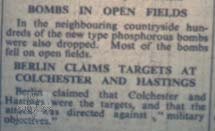
Newspaper cuttings from local newspapers in August 1944. Nurse Jean Rayner is the only person mentioned. During wartime there was strict censorship of what could be reported regarding enemy activity. No mention is made of Severalls Hospital or that it was located in Colchester. It was the Germans that claimed they made a strike in Colchester, unconfirmed by us. We hope to record the names of those killed at a future date. 38 women died as a result of the air raid. Other bombing raids in Colchester led to the deaths of 5 people in 1940 at the laundry at Distillery Pond and 9 deaths in Essex Street in 1944. Their names and details can be found here.
12 - Here we have the grave of Bishop Whitcombe. This information was sent to us by one of his grandchildren.
'My grandfather was the Right Reverend Robert Henry Whitcombe, M.A., D.D.Oxon., Bishop of Colchester 1909-1922, born in 1862 and who died in 1922. He was laid to rest in Colchester Cemetery on March 23rd 1922. My grandmother, Mrs. A.M.S. Whitcombe (Annie Maria) daughter of Samuel Thomas George Evans of Eton college, died and was laid to rest beside her husband in Colchester Cemetery in 1962.
He was a scholar of Winchester College, obtained a double first at Oxford University and taught mathematics and science at Wellington College and Eton, where he met and married Annie Maria Evans, the daughter of the drawing master. He ate all his dinners for a barrister, but was not called to the Bar. He was ordained in the Church of England, became Rector of Hardwicke, Bucks, Vicar of Romford and Archdeacon of Chalfont. He was consecrated Suffragan Bishop of Colchester in the diocese of St. Albans where he served until the diocese was split and Colchester became part of the Diocese of Chelmsford. He died of cancer age 60. There were 100 clergy at his funeral and the Bishop of Chelmsford in the course of an appreciation said, had he lived, he would have been called to even higher service in the church militant.
Miss J.S. Whitcombe
(one of his grandchildren)
see also here
Here are a selection of other gravestones or monuments to the great and good of Colchester.
To the Goody family members.
To Walter Edmund Thorrington, president of the Colchester and East Essex Co-operative Society for 17 years.
To the Goody family.
To the Kent and Blaxill families.
To catholic nuns of the town.
To Thomas John Ralling, Grand Secretary of the Winnock Lodge of Freemason for 47 years.
The 1881 census shows Thomas J. Ralling, aged 34, head of the household, living at Winnock Road, Winnock Lodge with his wife Ann and his two brothers and two young daughters. He was described as a Newspaper Agent Manager.
WILLIAM PECK
William Peck was buried with wife in Colchester Cemetery in grave L2437.
He was born in Buckden, Hunts on 23/2/1839. He was married in London to Lydia Gayford who was a first cousin of Charlie Chaplin's grandfather Spencer Chaplin. William Peck was a linen & woollen draper, hosier & haberdasher, silk merchant and manufacturer's agent, who had businesses in Colchester in Winsley's House in the High Street and in Stockwell Street. He became a town councillor of Colchester, and was a pioneering motorist in Colchester.
The following was supplied by Geoff Wiseman of the Southward Bowls Club who claimed to be one of the oldest bowlers in Essex, with an explanation:
How clubs were started in Colchester and Elmstead. My introduction to the game of bowls was in 1894 or 1895, when the late Councillor William Peck of Colchester presented a set of four pairs of woods for the public on the Colchester Recreation Ground. These bowls were eagerly sought for, intending players getting on the green early on Saturday afternoons so as to secure a pair and make sure of having a game. There was no green as we know them now, but just a small piece of green about twenty square yards, uneven, and very much out of level and with grass inches long. Nevertheless, we had many good games and thoroughly enjoyed them.
Information supplied by Andrew Mitchell of Wimbledon in March 2008
WAR GRAVES
There are war graves of both world wars in this cemetery. The 1914 -1918 burials total over 300, of which 50 are in the War Plot. 11 Australian graves are together in a group nearby, the remainder being scattered. After the war a 'Cross of Sacrifice' was erected on a site overlooking both the plot and the group of war graves, in honour of all the servicemen buried here. In the early months of the 1939-1945 war, shortly after the enlargement of the cemetery, land was set aside in the newer part for service war burials. This is now the War Graves Plot. Among these casualties are men who were killed at sea after being evacuated from Dunkirk. The non-war graves are those of a man of the Merchant Navy and two ex-servicemen who were buried in the War Graves Plot although their deaths were not due to war service.
The War Graves Plot is kept in very neat order, close to the cemetery's war memorial. The 'Cross of Sacrifice' stands on the western side. The graves are set in level mown turf, with continuous flower borders along the rows of headstones in which are polyantha roses and other seasonal flowers.
Here follows a series of pictures.
1. a postcard from c1919 showing 'Soldier's Corner' as it was then known, with many temporary crosses in place, the bodies having been recently brought back from Flanders and other battlefields.2. The same view in November 2011 with the new style CWGC headstones
3.Close up view of the bottom left cross to Gunner E E Watson of the RFA
4. The same grave in close-up in November 2011.
OUR BELGIAN HEROES
The above picture is of four 1914 -18 Belgian headstones, all in the French language (ie not Flemish). All these men died in 1914 with surnames Baudour, Verdoodt, Coquette, Van Bossuyt.
Au-dessous, les pierres tombales
Baudour
Fernand E L J
Sous-Lieut
4e. Regt. de Ligne
Né à Malines
Le 12 Août 1895
Mort pour la Belgique
Le 31 Octobre 1914
25552, Fernand Baudour, buried 2nd November, 8683, unconsecrated plot, P-8-1-3/253, minister J Bloomfield RC CF and
Fernand Emile Louis Jules Baudour, 31st October
Verdoodt
Pierre F
Caporal
1er Regt. de Carabiniers
Né à Wesembeek
Le 7 Mai 1895
Mort pour la Belgique
Le 6 Novembre 1914
25552, Felicien Verdoodt, buried 9th November, 8685, unconsecrated plot, P-8-2-3/253, minister Thomas W Clarke and
Pierre Felicien Verdoodt, 6th November
Coquette
Camille A
Soldat
1er Regt. de Chasse à Pied
Né à Courcelles
Le 18 Novembre 1890
Mort pour la Belgique
Le 2 Novembre 1914
25554, unknown male in military hospital, buried 3rd November, 16891, consecrated plot, S-2--86-4/144 or
Camille Augustin Coquette, 12th November, P-8-3
Van Bossuyt
Jean B-R
Soldat
5eme Regt. de Ligne
Né à Ruisbroeck
Le 26 Octobre 1887
Mort pour la Belgique
Le 26 Novembre 1914
25598, Boshaart, buried 1st December, 8698, unconsecrated plot, P-8-4-3/253, minister J Bloomfield RC CF and
Jean Baptiste Rene Van Bossuyt, 29th November
The smaller print information comes first, from the cemetery's own records and second, from the CWGC. The soldiers were catholics and so the plot was unconsecrated. The unknown soldier later (presumably) identified to be Camille Coquette, was buried in consecrated ground at another part of the cemetery and assumed to be a protestant. Jean Van Bossuyt's name was recorded wrongly by the British but corrected by the Belgians at a later date.
The Coquette headstone has a particular sadness to it (which may also be the case with the other three). Why were these Belgian heroes buried in Colchester? We assume that they were injured in battle in Flanders and brought back for treatment in England, only to die of their wounds? The headstones are not of the British pattern so we assume that they were provided by the Belgian government. We think that Camille Coquette is who is described as 'unknown soldier at the military hospital' in the cemetery records. This is probably why the official death records do not show him and perhaps why the Coquette family could not find him. The Belgian authorities must have correctly identified the body at a later date and the registers were never corrected. The body was buried in another location to that of his headstone, but we do not know whether it was re-buried in the plot with his brother Belgians. The sad story that attaches to Camille Coquette is as follows:
In 2007, we discovered this group of burials and thought them worthy of record. We knew a Belgian woman who lived in Colchester and so we showed the pictures to her. A cold shiver came to her as, only a few weeks before, she had learned of the death of the headteacher at the school at which she once taught, in Belgium. He was a priest and he had a sister who married a Coquette. The lady telephoned Madame Coquette in Belgium, and related the story of the Colchester Coquette that had been found. The sister went very quiet and the conversation became difficult to continue with. Our lady in England thought that perhaps she had done something wrong but, half an hour or so later, the lady in Belgium rang back and told how the stone must belong to her husband's great uncle. Apparently, a big mystery had been solved. This news had come as a shock. Camille's mother had died, heartbroken at having never discovered what had happened to her son. She and the family had searched graveyards across the country, in vain, trying to find him. Camille Coquette's grave has been found and the family are delighted.
May the time soon come when Colchester can welcome members of the Coquette family to England to visit the grave of their long lost heroic ancestor. One is led to wonder whether just such a story applies to the other three headstones? If the authorities tried to inform the families, the Coquette family do not seem to have learned of it? In this case, it appears to have taken 93 years for his family to find him?
http://militaryhistory.suite101.com/article.cfm/the_belgian_army_of_1914_
In 1914 the Belgian Army reflected the structure of the Belgian state - while the officers' corps was predominantly French-speaking, the majority of the men were Flemish. The Belgian Army had six infantry divisions (43,000 men), with 115,000 in reserve. This did not provide enough men to staff Belgium's fortresses on the country's border and the German Army quickly overwhelmed these defences in August 1914. King Albert I, the commander-in-chief of the Belgian Army, withdrew his forces and with the help of the British Expeditionary Army and the French Army, was able to hold a line just inside western Belgium.
King Albert was forced to move his government to Le Havre in France. The Germans now ruled most of Belgium and over the next few years was accused of carrying out atrocities against the civilian population.
Conscription of men in the small part of Belgium under Allied control raised the average strength of the Belgian Army to 170,000 men. A total of 267,000 men served in the army in the First World War, of whom about 54,000 were wounded and 14,000 killed.
Please link to this site for more Belgian war graves.
FERDINAND BAUDOUR
This picture was kindly sent by Danny Delcambre in Belgium. His website is at:
The picture is taken from the book:
LYR, René (Ouvrage collectif sous la direction générale de), "Nos Héros morts pour la patrie. L'épopée belge de 1914 à 1918 (Histoire et documentation). Tableau d'honneur des officiers, sous-officiers, soldats, marins et civils tombés pour la défense des foyers belges", Société anonyme belge d'imprimerie, Rue des Ateliers, 3, Bruxelles, 1923 - "Onze helden gestorven voor het vaderland. België's epische strijd van 1914 tot1918 (Geschiedenis en bewijsstukken). Eerelijst der officieren, onderofficieren, soldaten ,zeelieden en burgers die vielen voor de verdediging der belgische haardsteden", N.V. Drukkers en uitgevers maatschappij "Ons land", Sterckxstraat 9-11, Brussel, 1926
Merci Danny!
We visited the graves on Armistice Day, 11th November 2007,
to leave some flowers and a Remembrance Cross at each grave.
MORT POUR LEUR PATRIE
Died for their country.
+++++++++
This story has caused some upset in Belgium. It has been suggested that it brings discredit on the Belgian war graves organisation with our suggestion that the family were not informed. The Belgian authorities must have tried to contact the family but seem to have failed - for whatever reason. Added to that, the Coquette family are French speakers, which may explain the following Flemish comments seen on 'Forum Eerste Wereldoorlog'.
Dus de vraag "Why where the Coquette family not informed of what happened to their son", kan simpel beantwoord worden met : "Sorry, they were informed".
En de vraag "Why did it take 93 years for his family to find him?", kan nog eenvoudiger worden beantwoord met : "Because they were not interested and were rather sloppy with their own family history".
Graves visited on Friday 11th November 2008.
We visited these graves to place a cross beside each, to honour and remember these brave men who died and were buried in a foreign land. This piece of land will be forever Belgian. We feel it to be a privilege to have you here. 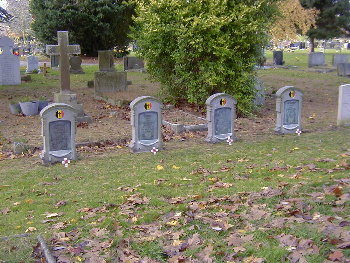

A marker for an Old Contemptible! He therefore presumably fought at Ypres and Mons and was an ‘Old Contemptible’ — part of the British Expeditionary Forces which the Kaiser called ‘a contemptible little army’. The grave is believed to be of SAMUEL C HOCKNEY who died on 26th December 1941, aged 68 years (born 1873 approx.). This would mean that he was about 41 in 1914, when his “old contemptible” soubriquet was earned. (Also in the grave are his wife and the cremated remains of another relative). It is an unpurchased grave and the grave number is W 11 43. The 1881 census shows a Samuel C Hockney, son of John and Mary Hockney, living and born in London. John Hockney was a railway Porter who was born in Yorkshire.
The National Archives tell us that he was a private in the Rifle Brigade, 2nd Battalion, regiment no. 3268. He enlisted 17th May 1894 and was discharged 16th May 1916 after 22 years of service. He was awarded the Victory Medal and the British War Medal and the Silver Medal. His medal card tells us that he was 'time expired' at his own request after 18 years service. It also states "sickness" and that he was in a in a TF (7th London) regiment and had served just over a year. He was considered to be no longer physically fit for active service.
The Essex County Standard of 3rd January 1942 mentions his funeral and states that he lived at 152 Canterbury Road, Colchester and that his death on Boxing Day was sudden. He served two years in the Great war, was in the Egyptian Campaign and later in the defence of Ladysmith. He had eight sons. He enlisted in the Rifle Brigade in 1894 and served in the Omdurman Campaign in 1898 and in the Ladysmith Siege. He went to France in 1914 with the British Expeditionary Forces and was invalided home in 1916. He was the possessor of seven medals - two for Omdurman, one for Ladysmith, the 1914 medal and star, Victory medal and general service and long service medals. He served with the Royal Engineers as a storeman and later with F W Brackett for 21 years. Mr T Holden, Mr I Holt and Mr J Andrews, all Old Contemptibles were in attendance and it appears that his 'local' was the Recreation Hotel.
The term "Old Contemptible" was adopted by the Veterans of the 1914 BEF, as a result of the Kaiser's reference to "wiping out this contemptible little Army" His derisory remark, in true British Fashion, was adopted with fervour & entered the vocabulary. The Veterans organisation of that name was founded after the War. It's members being limited to those entitled to wear the 1914 Star, so basically any of those units that received the Medal would have been Old Contemptibles, though few, if any, apart from The Royal Horse Artillery & Royal Engineers, titularly, remain as they were in 1914.
Thanks to Penny Stynes, Crematorium & Cemetery Manager and several experts of the Great War Forum, for much of this information.
And another 'Old Contemptible' at location P/1/63. It is believed that this marks the final resting place of John Patrick Carney of St Botolphs parish, who died on the 20th June 1938 and was buried in Colchester Cemetery on 24th June 1938 at the age of 45 years. His medal card shows that he was in the Royal Field Artillery, Regiment Number L/40168 and was awarded the Victory Medal.
The 1901 census suggests that he was born in 1893 in Liverpool and that his mother was Julia, a widow in 1901.
Our research is ongoing. Can anybody tell us more about him?
Thanks to Penny Stynes, Crematorium & Cemetery Manager, for identifying this marker's owner.
Other
'Old Contemptibles'
Burials
that we know of are as follows:
If anybody would like to send in details of Old Contemptible burials, we will be pleased to add them here to assist future researchers. Frederick Isaac English of 40 Halstead Road, Colchester.
'A Colchester Old Contemptible'
Died in June 1938 at the age of 48 years and was given an ante-grave service at Lexden Methodist Church. He rose to the rank of acting Sergeant in the 1st Kings Royal Rifles (Regt. No. 7505). He was holder of the DCM and was awarded the French Medaille Militaire during the Great War in which he was five times wounded and twice gassed. He was buried in Lexden churchyard.
He was born in Colchester in the first quarter of 1890 although we are unable to find him in the 1891 or 1901 census.
See his obituary in ECS 3rd July 1938 and in the Colchester Gazette. The articles mention attendance at the funeral of other OCs.
READING, BERKSHIRE
http://www.eastreading.com/neighbour/cemetery/index.shtml
Three 'Old Contemptibles' are buried in this cemetery
Captain Philip Knightley, RAMC, died April 9th 1965
Lance Corporal William Marshall MM, 2nd Royal Berkshire Regiment
2nd Lieutenant Ernest William Ellis, 5th Royal Berkshire Regiment

and a memorial to Yep Fook of the Chinese Labour Corps who died two days before Armistice Day,
'Faithful unto Death'.
Grave visited on Tuesday 11th November 2008.
The Chinese Labour Corps, nicknamed the Celestials, were Chinese auxiliaries sent to work for French and British troops during the First World War and do the hardest menial jobs. We can only guess at what sort of person Yep Fook was or what his work entailed. He was presumably injured on the battlefield and brought to Colchester for treatment, where he ultimately lost his life. What he would have made of the Christian cross that we laid at his grave we cannot know but, 90 years after he lost his life, only two days before the end of the war, he is remembered.
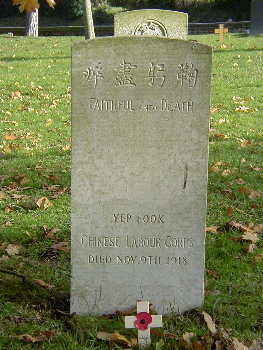
To learn more of how the Chinese helped in the war, please click on this link here.

There are many persons of note that we hope to mention in the goodness of time.
EDMUND FOWLER VC
Zulu War Hero
Edmund John Fowler was awarded the Victoria Cross for bravery in the field of battle during the Zulu War. He was born in Waterford, Ireland in 1861. He was around 18 years old, a private in the 2nd Battalion, The Cameronians (Scottish Rifles), British Army. The following deed took place, for which he was awarded the VC
On 28 March 1879 at the Zlobane Mountain, South Africa, Private Fowler, with a captain and a lieutenant (Henry Lysons) dashed forward in advance of the party which had been ordered to dislodge the enemy from a commanding position in natural caves up the mountain. The path was so narrow that they had to advance in single file and the captain who arrived first at the mouth of the cave was instantly killed. The lieutenant and Private Fowler undismayed by the death of their leader, immediately sprang forward and cleared the enemy out of their stronghold.
He later achieved the rank of Colour-Sergeant. He died in Colchester, Essex, on 26 March 1926. The Victoria Cross is the highest and most prestigious award for gallantry in the face of the enemy that can be awarded to British and Commonwealth forces. His Victoria Cross is displayed at the Cameronians Regimental Museum (Hamilton, Lanarkshire, Scotland).
He lived the rest of his life in Colchester, for some years landlord of the Live and Let Live pub in Stanwell Street. His grave is marked at location Q6 between two tall trees, along edge of the path, a flat kerb covering two graves.
ISAAC POOLEY
Battle of Trafalgar Hero
Isaac Pooley, who fought on board HMS Victory at the Battle of Trafalgar, is located at L20, a plain vertical slab stone.
COLCHESTER FIRE SERVICE
Lieutenant Frank Naylor
An elderly woman told how she watched the only Colchester firefighter killed in the line of duty fall to his death. Phyllis Whittaker was just nine years old and on a birthday outing to Colchester on the fateful day, July 31, 1923. She had travelled with a neighbour from her home in Ardleigh for a treat - a glass of lemonade at a High Street tea shop next to the Hippodrome. She never got her lemonade, because while they were in town they saw firefighters from Colchester Corporation Fire Brigade tackling a blaze at Paull's cycle shop. They joined a crowd which had gathered to watch the drama. Mrs Whittaker, 84, of Abbots Road, Colchester, said: "We stopped and looked up. The blaze was not so bad then but I could see a fireman up there on the roof. They didn't have long ladders in those days. "I saw the chimney stack wobbling, it was as if it was waving in the breeze and it came down and it looked as if the fireman went straight into the flames. He crashed to the ground and the whole crowd screamed, the ladies cried and I screamed as well. They didn't have ambulances in those days and he was taken by handcart to Essex County Hospital."
Mrs Whittaker came forward to speak about her memories in 1999 when she learned that the dead firefighter, Lieutenant Frank Naylor, had lain in an unmarked grave for more than 70 years. She said: "I have got an extremely good memory. I realised a fireman had fallen but now know he didn't fall into the fire. That's all I ever saw and that was quite enough. I am so glad that he is to get a headstone at last."
Mr Naylor's headstone was unveiled at a special ceremony at Colchester Cemetery on July 31st 1999. His grandson, Brian Baker, of Shelley Road, Lexden, organised the event and other family members attended, along with Colchester firefighters and borough dignitaries.
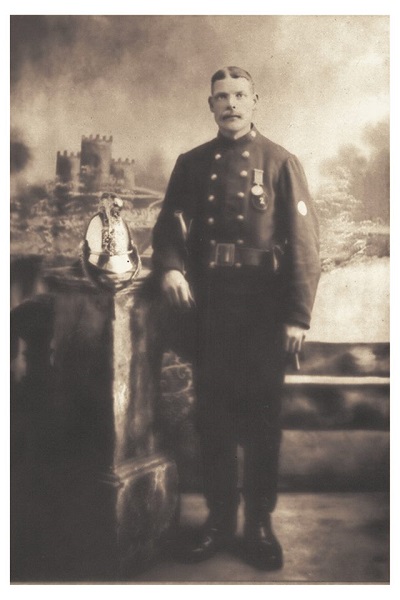
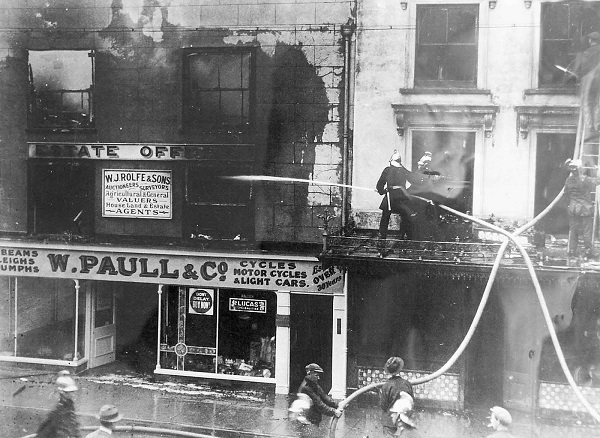
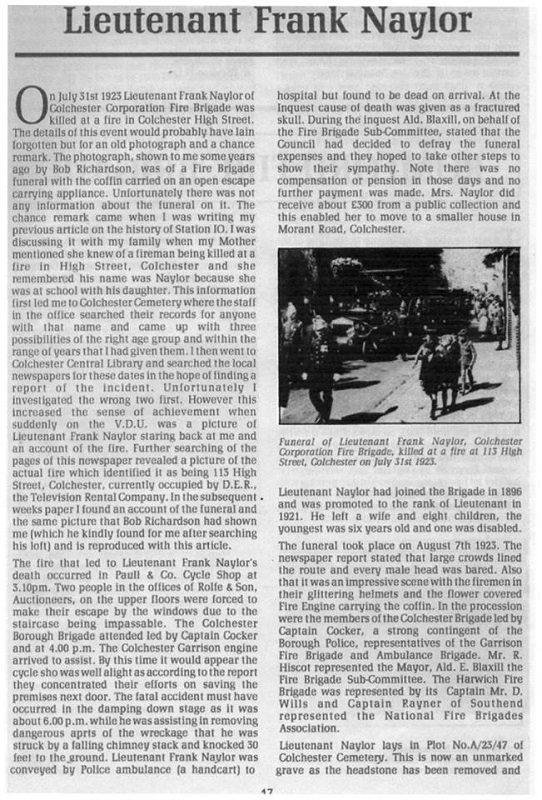
OTHER COLCHESTER CEMETERIES
Some other Colchester graveyards are as follows:
Earliest - Romano-British - Christian and Pagan
1st 2nd, 3rd and 4th century Romano British graveyards found to the south of the town wall in the vicinities of Butt Road, Lexden Road, Maldon Road roundabout, St Giles church, to the south of the Circus Victricensis. These graveyards have been destroyed by Victorian building works and, more recently, excavated by archaeologists, with many of the bodies and grave goods displayed at the Colchester Museum. Perhaps the most famous of the Colchester headstones found are those to Longinus Sdapeze (c50 AD)
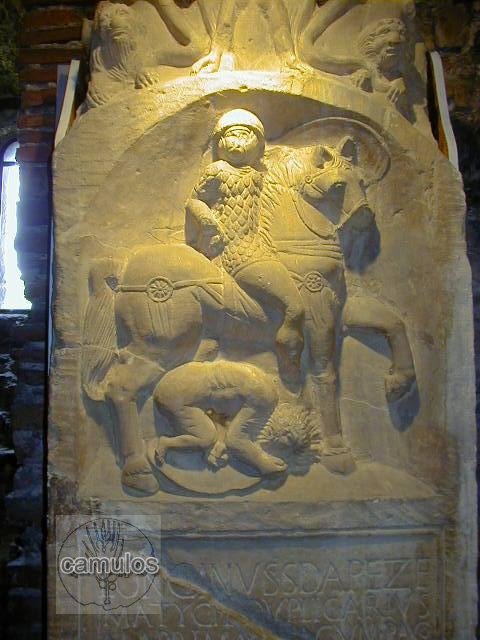
... and Marcus Flavonius (c150 AD), both on display in the castle.
Remains of the earliest Christian church in Britain, c330 AD, next to the Police Station on Southway.
The Eight Medieval Church Graveyards within the town walls - originally Church of Rome (Catholic) but becoming English Protestant after the reformation.
All Saints, Holy Trinity, St James the Great, St Martin, St Mary at the Walls, St Nicholas, St Peter, St Runwald.
Whilst St Runwalds and St Nicholas churches have been destroyed, many of their gravestones can still be seen on the site of these churches.
The Medieval Church Graveyards outside the town walls
St Botolphs (rebuilt in Victorian era), St Giles, St Leonard at the Hythe.
The graveyard at St Mary Magdalen on Magdalen Street was desecrated in the 1980s to make way for housing. The remains were removed by archaeologists.
Outside the main town area are medieval church graveyards at St Andrews in Greenstead and at Berechurch, and the much decayed church of Stanway now within the Zoo grounds. There are also, of course, many other churches with graveyards, the further out you go, such as at Lexden, Wivenhoe, Rowhedge, Fordham, Marks Tey, etc.
Non-Conformist Burial Grounds
Quaker burials to rear of the Chapel of St Helena and in Roman Road. There was also a burial ground in Priory Street, where the car park is now situated. One presumes that, in the latter case, the dead lie beneath the asphalt.
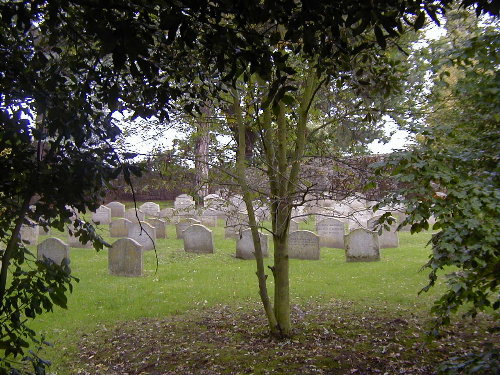
Stockwell Chapel in St Helens Lane has its graveyard now used as a car park with many of the stones still on display around the site perimeter.
Eld Lane Baptist Church in Eld Lane uses its burial site for car parking and recreation areas, although many stones are still on view.
Later Period Church Graveyards
The Camp Church on Miltary Road has many burials, mainly from the Napoleonic period, with a few gravestones on view.
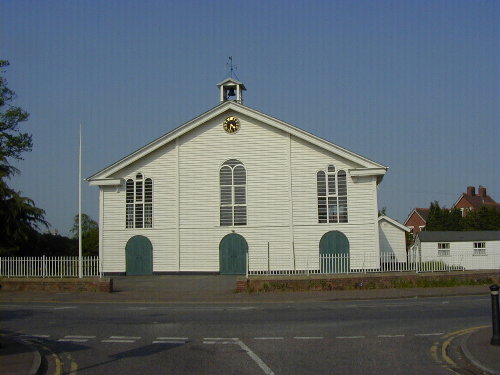
St Stephens Church in Canterbury Road
All Saints Church in Lexden
Out of England Faith
There was a jewish synagogue in the Dutch Quarter of the town at one time, although it is not known where its people buried their dead. Somebody once said that the floors of a house on the west side of East Gates was made up of jewish gravestones. This is probably a fanciful claim but may have some truth in it. Also, the Flemish weavers who migrated to Britain are presumed to have buried their dead in the graveyard of St Martins church. The following modern inscription was added to the original Dutch/Flemish weavers gravestone in St Martins church yard.
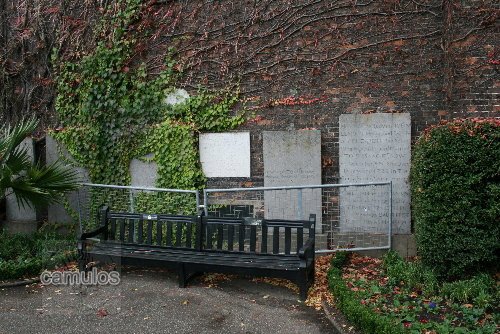
The above gravestones are located on the east wall of Hollytrees Museum. Why are they there?
Please let us know of other gravestone sites in Colchester that we have missed?
Do not stand at my grave and weep
I am not there; I do not sleep.
I am a thousand winds that blow,
I am the diamond glints on snow,
I am the sun on ripened grain,
I am the gentle autumn rain.
When you awaken in the morning's hush
I am the swift uplifting rush
Of quiet birds in circled flight.
I am the soft stars that shine at night.
Do not stand at my grave and cry,
I am not there; I did not die. Mary Frye
to contact us by email, click below Sdapeze This page created 27th October 2007 last updated 14th June 2020
